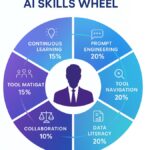The future of work isn’t coming. It is already here, and it is taking place in your living room. At MahadJobs.com, we’re tracking how remote work in 2026 has evolved far beyond simple video calls and shared documents. Artificial intelligence now powers every aspect of distributed work, creating opportunities that seemed impossible just years ago.
Remote work in 2026 represents a complete reimagining of professional life. AI doesn’t just enable working from home; it enhances productivity, collaboration, and work-life balance in ways that make traditional offices seem antiquated. Understanding these transformations helps job seekers position themselves for the most exciting opportunities in this new landscape. Changing for remote work agreements.
Remote Work in 2026: AI-Powered Virtual Offices Replace Physical Spaces
In 2026, the concept of remote work will centre on immersive virtual environments. AI creates personalised digital workspaces that adapt to individuals’ preferences and work styles. These aren’t simple video conferencing tools; they’re sophisticated environments where presence feels real and collaboration happens naturally.
Virtual reality meetings powered by AI allow teams to share 3D models, manipulate data visualisations together, and read body language using advanced avatar systems. AI translates languages in real time, enabling seamless global collaboration. Regardless of the team members’ location, background noise cancellation and automatic transcription guarantee seamless collaboration.
Intelligent Productivity Assistants Maximize Output
Remote work in 2026 benefits from AI assistants that understand context and anticipate needs. These systems manage schedules across time zones, prioritise tasks based on deadlines and their importance, and even suggest optimal work hours based on individual productivity patterns.
AI monitors workload and suggests breaks to prevent burnout. It identifies collaboration opportunities, connecting team members working on related projects. Smart document management ensures everyone accesses the latest versions, while AI-powered search finds information instantly across all platforms.
Automated Onboarding and Training
Starting a new remote position in 2026 feels surprisingly smooth thanks to AI-driven onboarding. Personalised training programmes adapt to learners’ speeds and styles. Virtual mentors provide 24/7 support, answering questions and guiding through company processes.
AI creates realistic work scenarios for practice, providing feedback and suggestions for improvement. New employees reach full productivity faster than ever, despite never meeting colleagues in person. This transformation of remote work in 2026 makes geographic boundaries irrelevant for talent acquisition.
Enhanced Security Through AI Monitoring
Remote work in 2026 addresses security concerns through sophisticated AI systems. Behavioural authentication continuously verifies user identity based on typing patterns, mouse movements, and work habits. Anomaly detection identifies potential security threats before they materialise.
AI manages access permissions dynamically, granting system access based on current projects and needs. Encrypted communication channels protect sensitive data, while AI monitors for potential breaches. These security measures happen invisibly, allowing employees to focus on work rather than complex security protocols.
Work-Life Balance Optimization is Changing for Remote
Perhaps the most significant change in remote work in 2026 involves AI’s role in maintaining healthy boundaries. Intelligent systems recognise signs of overwork and automatically suggest breaks or end-of-day notifications. They manage communication flow, batching non-urgent messages to reduce interruptions.
AI analyses productivity patterns to recommend optimal schedules. Some professionals work split shifts aligned with their natural energy levels. Others concentrate work on focused four-day weeks. The flexibility enabled by AI makes remote work sustainable long-term.
Global Talent Pools Become Reality
Remote work in 2026 truly democratises opportunity. Companies access global talent without relocation costs or visa complications. Professionals in smaller cities compete equally with those in major metros. AI handles time zone coordination, cultural communication nuances, and collaborative logistics.
This global approach benefits everyone. Companies seek specialised skills, regardless of location. Professionals enjoy career opportunities without uprooting families. Local economies benefit as high-paying jobs arrive without requiring physical corporate presence.
Skills for Remote Success in 2026: Thriving in remote work in 2026 requires evolved skill sets:
Technical Proficiency
- Fluency with AI collaboration tools
- Virtual reality meeting navigation
- Digital security awareness
- Cloud platform expertise
Soft Skills
- Self-motivation and discipline
- Asynchronous communication mastery
- Cultural sensitivity for global teams
- Digital relationship building
AI Collaboration
- Prompt engineering for productivity tools
- Understanding AI assistant capabilities
- Data interpretation skills
- Workflow optimization expertise
Industries Leading the Remote Revolution
While remote work in 2026 spans all sectors, some industries lead adoption:
- Technology and software development
- Digital marketing and creative services
- Financial services and consulting
- Education and training
- Healthcare (telemedicine and administration)
Preparing for Your Remote Future
The transformation of remote work in 2026 creates unprecedented opportunities for prepared professionals. Start building relevant skills today. Experiment with AI tools. Develop strong digital communication abilities. Create an optimal workspace in your home. Remote software engineers.
Ready to explore remote opportunities powered by AI? Visit MahadJobs.com to discover positions at companies leading the remote work revolution. Upload your resume and let our AI-powered matching connect you with your ideal remote role. The future of work is flexible, global, and AI-enhanced; make sure you’re part of it.


